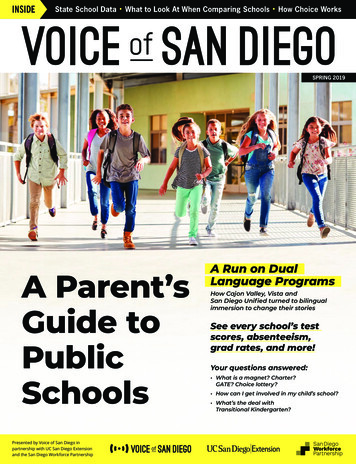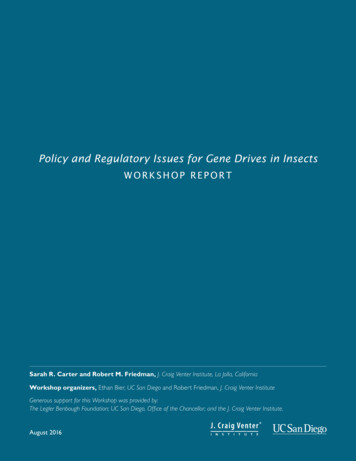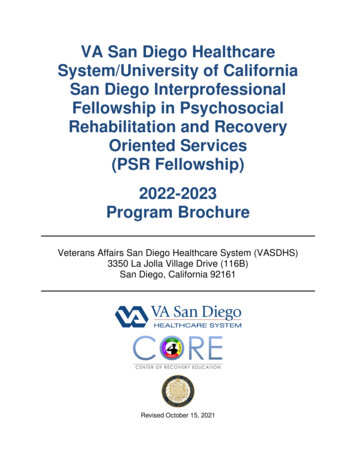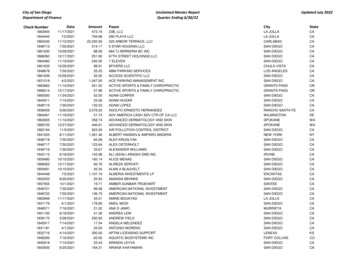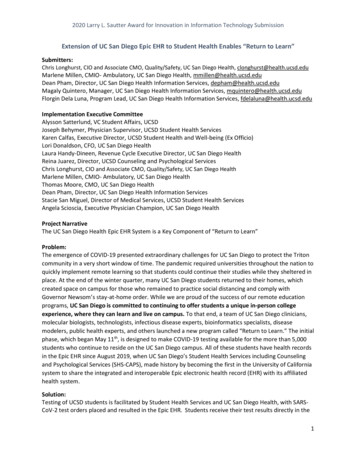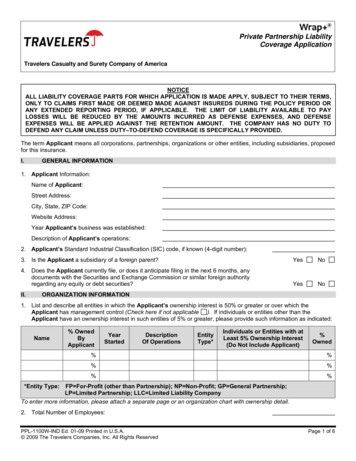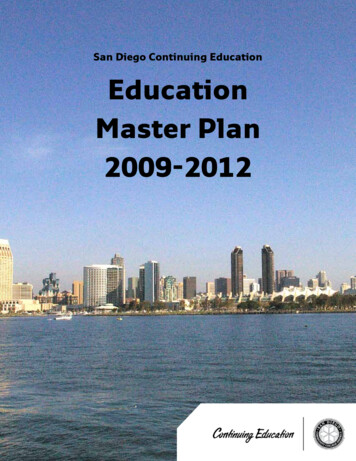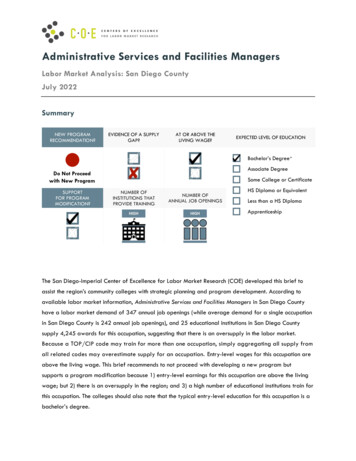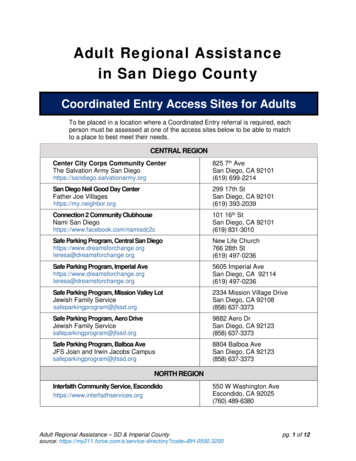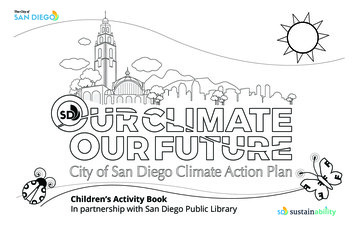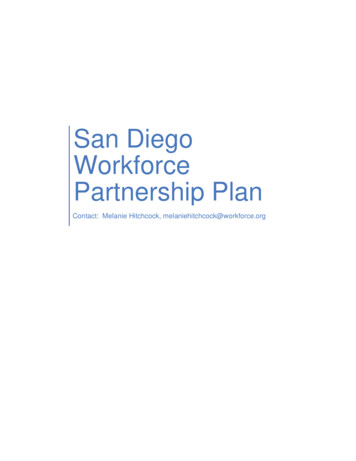
Transcription
San DiegoWorkforcePartnership PlanContact: Melanie Hitchcock, melaniehitchcock@workforce.org
Table of Contents1. Background . 12. Strategic Vision . 13. Service Delivery: strategies for ensuring equitable access to the regional sectorpathways and industry recognized post-secondary credentials . 34. Partnerships: Existing partnerships from the past plans for service deliveryintegration, braided resources and support . 65. MOU Management/One Stop Operator: coordination of services and resourcesidentified in their MOU . 76. Co-enrollment: Partners work toward co-enrollment and/or common casemanagement as a service delivery strategy . 107. Remote Access: facilitating access to services provided through the one-stopdelivery system . 128. Supportive Services: Coordination of workforce and education activities withsupportive services . 129. Disabilities: Compliance with WIOA Section 188 and applicable provisions of theAmericans with Disabilities Act of 1990 regarding accessibility for individuals withdisabilities . 1310. Coordination for the Competitive Integrated Employment Blueprint for individualswith developmental and intellectual disabilities . 1411. Coordination with ounty Health and Human Services Agencies and others servingindividuals who access Cal Fresh E&T services . 1612. Coordinate with Local Child Support Agencies and other local partners who serveindividuals who are non-custodial parents . 1713. Coordination with community-based organizations others serving individuals whoare English language learners, foreign born, and/or refugees. 1814.Coordination of workforce investment activities for rapid response . 1915. Assessment of the type and availability of adult and dislocated workeremployment and training activities . 2016.Assessment of the type and availability of youth workforce investment activities 2217. Staff Development including digital fluency and distance learning, culturalcompetencies and an understanding of the experiences of trauma-exposed populations2318. Fiscal Agent: The disbursal of grant funds as determined by the Chief ElectedOfficial (CEO) or the Governor, and the competitive process to award the sub-grantsand contracts for WIOA Title I activities . 24
1. BACKGROUNDThe San Diego Workforce Partnership (Workforce Partnership) is the local workforcedevelopment board in San Diego County. All local workforce development boards arerequired under the legislation of the Workforce Innovation and Opportunity Act (WIOA)to participate in regional and local planning. As a local workforce development board,the Workforce Partnership is charged with providing workforce services to adults,dislocated workers, youth and employers by funding job training programs thatempower job seekers to meet the current and future workforce needs of employers inSan Diego County. The Workforce Partnership is part of the Southern Border Region(SBR), a two-county region located in the southern-most point of California.2. Strategic VisionThe mission of the San Diego Workforce Partnership is to empower job seekers to meetthe current and future workforce needs of employers in San Diego County. Our Vision isfor every business in our region to have access to a skilled workforce and every jobseeker to have access to meaningful employment.To accomplish this, we equip job seekers to increase their economic mobility; we helpbusinesses grow, rebuild, and thrive equitably; and we prepare children and youngadults for the world of work. We understand that workforce development is much morethan finding the next job; and we believe that career preparation begins in theclassroom but continues throughout life. We offer services, custom programs andunique initiatives that are redefining what workforce development can—and must—be,because everyone deserves the opportunity to succeed.2.1 The strategic vision to support economic growth and self-sufficiency overthe next four yearsOur strategic foundation is the five regional pillars, Job Quality, Inclusive BusinessGrowth, Outcomes Focused Funding, 2-Generational Solutions and Population-SpecificInterventions. These strategies and their specific 2025 goals are found here: StrategicPillars. Through these, we work to build infrastructure and find evidenced basedprogramming that produce measurable outcomes that help families become selfsustaining and businesses thrive. We orient all our work, regardless of funding source,around these pillars.Job Quality is about simultaneously producing outstanding outcomes for businessesand their frontline workers. It is also understanding that a quality job means differentthings to different people at different times in their lives and every business does nothave the capacity and resources to meet everyone’s definition of quality. To that end,employers were engaged along with some of their workforce to produce a definition ofquality and then to conduct experiments to understand the value that particular qualitybrings to their business and employees. This supports business and connects to theInclusive Business Growth pillar that focuses on equipping small and mid-sized1
businesses to compete by meeting their needs for a diverse, skilled workforce. If theworkers quality needs can be supported by the company, it will keep a skilled andengaged workforce that can help it thrive in a highly volatile, competitive environment.Particularly in the recovery period following the COVID-19 pandemic, recognizing thevalue add to businesses of keeping quality processes and benefits like stablescheduling and family leave will aid in economic recovery of the County.2-Generational solutions are focused on creating opportunities for andaddressing needs of both children and the adults in their lives together. To this end, weare creating student focused work centers in middle schools. The Launchpad in one ofour school district partner’s middle schools is staffed by educators and designed withstudents to provide a familiar space for them to explore career and educationopportunities during and after high school. In this space, their families can also comeand discover work opportunities and then connect with an America’s Job Center ofCalifornia (AJCC) to further their own journey to family sustaining employment.Outcomes Focused Funding solutions focus on the efficient and effective use ofresources to solve intractable social and economic problems. As part of this work, welaunched our Income Share Agreement (ISA) fund which enables individuals to studywithout paying anything out of pocket and repay only if they enter a job making above 40K annually. We have also made investments in our IT infrastructure to support morein-depth analysis which will enable us to not only shift contracts to outcomes-basedmodels but also look at emerging trends across funding streams.Population-Specific Interventions focus on deepening our programming, which istruly differentiated, and standardizing common functions in order to better respond tothe needs of the community. This pillar considers how to connect programs, servicesand organizations to best serve participants as a whole person.2.2 Equity and InclusionEquity and inclusion are core to who we are and cut across all our work. We haveembraced the framework of Listen, Learn, Act as the vehicle to incorporate DEI into allwe do. This starts with elevating BIPOC voices and then operationalizing change. Theboard approved the addition of two new organizational values in February as a meansto publicly name our commitment. Equity - Proactive assessment and implementation of policies, practices,behaviors, and actions that result in access to opportunities, fair treatment, andequitable impact and outcomes for ALL customers, staff, and stakeholders; and, Inclusion - Create safe spaces that foster a culture where everyone feelswelcomed, seen, respected, supported, valued, and empowered to fullyparticipate.The Board of Directors has also voted to stand up a permanent committee to addressthese important issues and will be tackling everything from raising funding to supportBIPOC communities to building mentorship programs.2
3. SERVICE DELIVERY: STRATEGIES FOR ENSURING EQUITABLE ACCESSTO THE REGIONAL SECTOR PATHWAYS AND INDUSTRY RECOGNIZEDPOST-SECONDARY CREDENTIALSSan Diego is one of the fastest-growing counties in the country. It is comprised of 72high-growth, high-wage, in-demand occupations in seven high-priority sectors, includingEnergy, Construction & Utilities, and Information & Communication Technologies (ICT)and Digital Media.These priority jobs pay at least 90% of workers 16 an hour or more, provide at least 63openings a year and are projected to grow by at least 6.5% annually. Living wage for asingle individual in San Diego is currently 17.65 an hour.One of the most serious challenges currently facing these sectors is a tight supply ofskilled workers. These historically homogeneous industries need help prioritizingdiversity to broaden their talent pipeline, particularly with women and people of color.The Workforce Partnership has reevaluated its business structure to better serve ourcommunity and is orienting all direct service to in-demand industries in San Diego. Toillustrate what job readiness means for us locally across all of our sectors, the followinginfographic demonstrates the depth of resources to ensure all job-seekers are preparedfor their next career:3
We leverage our My Next Move Framework which helps participants understand howthe things they love can align with the needs of the market and set them on a path tofamily sustaining wages. A key part of this framework is job quality. As part of our jobquality efforts, we have developed a definition of job quality that serves as a standardfor the community while being responsive to individual needs and have embedded thisin our work, particularly in the My Next Move and the portal experience for job seekersand employers. We started the build out of not only the job quality framework (JobQuality) but videos and resources through my Next Move (My Next Move San DiegoWorkforce Partnership) to meet individuals where they are by connecting their intereststo labor market needs. We are specifically creating tools to assist workers in assessingtheir interests and preferences, gaining knowledge and skills, exploring priorityoccupations (wages, skills, etc) and understanding the job quality features mostimportant to them. However, this is as important for future job seekers as present jobseekers and arguably even more so.4
Employers are a key part of any individual’s next move so we partner closely withemployment leaders to ensure our job seekers are meeting their labor needs while alsopreparing for a career beyond the entry-level job. While approaching this work from theworker perspective, the employer needs are also met through a cohesive system thatsupports workers and employers. To achieve this, the Workforce Partnership is fullyengaged with the Talent Pipeline Management (TPM) approach through Advancing SanDiego, work led by the San Diego Regional Economic Development Council (EDC).TPM is an employer-led, demand-driven workforce process that applies supply chainmanagement strategies to talent acquisition, ultimately reducing the skills gap andsolving for skilled talent shortages. Through the Advancing San Diego initiative, theWorkforce Partnership and the San Diego Regional EDC work closely with the SanDiego and Imperial Counties Community College Association (SDICCA) to organizeemployer collaboratives, engage in demand planning, communicate competency andcredential requirements, analyze talent flows, and build talent supply chains. This TPMwork supports job quality and inclusive business growth by working with high roademployers with in-demand occupations to identify “preferred providers” of skilled talent,and expand talent pipelines and credentialling pathways to support access byunderrepresented job seekers. We have made extensive progress in both the ICT andHealthcare sectors using this model and will continue to expand this across our othersectors over the coming years.To operationalize this for the job seeker, the Workforce Partnership will continue tomove forward with better and effective online experiences that support easy access.Between navigating the financial impacts of unemployment or underemployment,enrolling in safety net programs, and managing their job search, job seekers alreadyhave enough on their plate. They don’t have the time and energy to work through acomplicated, bureaucratic Workforce Development system. We’re moving to anintegrated service delivery system to make it easy for job seekers in our region to getthe help they need with one phone number to call, self-serve online resources, and self-5
service career appointment scheduling. We will monitor success with a customerfeedback solution.The other part of operationalizing pathways is looking at early workforce development.This means, engaging students in their schools around workforce knowledge and skilldevelopment to meet the regional needs in the future. Moreover, this supports our 2Generational strategies serving parents and family as students engage and exploretheir future career options. Presently, the Workforce Partnership is engaging with middleand high schools to provide teacher training on Career Coach and labor market data tohelp students and their families learn in a supportive environment. In 2020, welaunched the first career center in a middle school, called the Launch Pad, and areworking to expand this model to other schools in our County. Research shows thatstudents’ career aspirations are most heavily influenced by the people around them. Inthe Launch Pad, students will have the opportunity to meet adults with similar intereststo their own and broaden their exposure to new career possibilities.These strategic moves toward easy online experiences and early education must besupported by access. Many of our most vulnerable communities have poor or nonexistent internet bandwidth. While the residents lack hardware and training on how touse them. The Workforce Partnership is committed to address these needs throughcontinuing engagement in new funding opportunities to support these needs and policychanges to allow for these support services to be as easily accessed as bus passes andgas cards.4. PARTNERSHIPS: EXISTING PARTNERSHIPS FROM THE PAST PLANS FORSERVICE DELIVERY INTEGRATION, BRAIDED RESOURCES ANDSUPPORTDue to the pandemic closing our AJCC doors, we have had to rely on partnerships foraccess to participants and referrals to reach those most in need. Partnerships are keywithin the region to connect participants to a broader array of wrap-around services.The San Diego Workforce Partnership prioritizes partnerships with organizations thatoffer substance abuse counseling, mental health services, housing services, childcare,and other public assistance programs. The basis of these partnerships is to create aworkforce system that is skill-based and moves participants through a set of valueadded services designed to increase their stabilization of basic needs, increaseemployability, and chances of retaining jobs. Through partnerships that offer wraparound supportive services we can maximize the impact of workforce services toparticipants that will address barriers to employment.The Workforce Partnership partnered with 211 San Diego’s Community InformationExchange (CIE) ecosystem comprised of multi-disciplinary partner networks that uses ashared language and integrated technology platform to deliver enhanced communitycare planning. CIE enables community based organizations, workforce, and correctionspartners to shift away from a reactive approach to providing care, to one that enablespartners to integrate data from multiple sources and make bi-directional referrals tocreate a longitudinal record that promotes proactive, holistic, person centered system ofcare.6
The CIE is an established platform that facilitates our community moving furtherupstream and to a more proactive system through closed loop referrals and the creationof a single, unduplicated record and community-wide care plan. The CIE is an evergrowing network of 76 committed health care, human and social service organizationswith more than 900 individual users delivering person-centered care and integrating andsharing data using an interactive cloud-based platform that contains identifiable andlongitudinal records of each individual’s progress toward health and wellness goals. TheCIE is a proven tool that is driving innovation and collaboration here in San Diego andbeing replicated in communities across the nation. 211 developed a CIE Toolkit and ismentoring dozens of communities across the country working to develop their own CIEto drive system efficiencies and effectiveness, reducing costs, and advancing equity.Over the coming years, we will continue to expand our integration with 211 and otherentities to facilitate serving individuals as whole people.Partnership with WIOA core and required partners is supported through efforts such as211 as well as through existing MOUs which govern the AJCCs. We also leverageadditional tools such as a Salesforce-based partner portal which enables the sharing ofreferrals for job postings in an effort to expedite the process for all involved.Finally, more extensive partnerships are setup for specific projects or sectors. Forexample, in the energy and construction space, deep work is being done with the localunions who run many of the jobs, as well as educators who provide related skill buildingcourses to flow successful completers directly into quality jobs with organizations suchas SDGE, Tesla and the unions themselves.5. MOU MANAGEMENT/ONE STOP OPERATOR: COORDINATION OFSERVICES AND RESOURCES IDENTIFIED IN THEIR MOUThe Workforce Innovation and Opportunity Act (WIOA) requires that a Memorandum ofUnderstanding (MOU) be developed and executed between the Local WorkforceDevelopment Board and the AJCC partners to establish an agreement pertaining to theoperations of the AJCC delivery system. The purpose of the MOU is to establish acooperative working relationship between the parties and to define their respective rolesand responsibilities in achieving the policy objectives. The MOU also serves to establishthe framework for providing services to employers, employees, job seekers and othersneeding workforce services.The San Diego Workforce Partnership functions as the Local Workforce DevelopmentBoard throughout the County of San Diego. The Workforce Partnership competitivelyprocured a subrecipient to function as the One Stop Operator and Service Provider ofthe AJCC system. This MOU represents an agreement between the San DiegoWorkforce Partnership, the AJCC One Stop Operator, WIOA required partners, and allother partners.7
California’s One-Stop delivery system via the AJCCs, develops partnerships andprovides services to achieve three main policy objectives established by the CaliforniaWorkforce Development Strategic Plan: Foster demand-driven skills attainment; Enable upward mobility for all Californians; and Align, coordinate, and integrate programs and services.These objectives will be accomplished by ensuring access to high-quality AJCCs thatprovide the full range of services available in the community for all customers seekingthe following: Employment; Building basic educational or occupational skills; Earning a postsecondary certificate or degree; Obtaining guidance on how to make career choices; and Hiring skilled workers.A comprehensive AJCC is one that provides universal access to the full rangeof employment services, training and education, employer assistance, etc. In otherwords, a comprehensive AJCC is a physical location where job seekers and employershave access to the programs, services, and activities of all the required AJCC partners.The San Diego Local Workforce Area has three comprehensive AJCCs listed below.Affiliate AJCCs is defined as sites where one or more AJCC partner programs, services,and activities are available. Specialized AJCCs is defined as sites that address specificneeds, including those of dislocated workers, youth, or key industry sectors orclusters that connected to the AJCC network. The San Diego Local Workforce Areahas three affiliate AJCCs listed below.The website for all AJCC’s is www.workforce.org, and point of contact is Maxine Suka –(619) 266-4276, maxinesuka@workforce.org.Comprehensive AJCC’sMetro Career Center4389 Imperial Ave.San Diego, CA 92113Met Baseline and Hallmark of Excellence CertificationSouth County Career Center1111 Bay Blvd.Chula Vista, CA 91911Met Baseline and Hallmark of Excellence Certification8
North Coastal Career Center1949 Avenida del Oro, Ste. 106Oceanside, CA 92056Met Baseline and Hallmark of Excellence CertificationAffiliate AJCC’sEast County Career Center151 Van Houten Ave.El Cajon, CA 92020Met Baseline and Hallmark of Excellence CertificationNorth Inland Career Center(located in the LiveWell Center)649 W. Mission AvenueEscondido, CA 92025Met Baseline and Hallmark of Excellence CertificationBank of America Merrill Lynch Workforce Development Center330 Park Blvd, Room #555San Diego, CA 92101Met Baseline and Hallmark of Excellence CertificationThe purpose of the one-stop delivery system is to bring together workforcedevelopment, education, and other human resource services in a seamless, customerfocused network of providers, thereby enhancing customer access. The goal is toimprove long-term employment outcomes for individuals receiving assistance. One-stoppartners administer separately funded programs as a set of integrated streamlinedservices to customers. The common one-stop delivery system is identified andstructured through the AJCC network.The Workforce Partnership manages 6 AJCCs throughout San Diego County. While theone-stop system may provide services at these brick and mortar locations, it may alsobe connected through other methods of access and referrals.Overview of One Stop Operator Duties - As the one-stop operator, our vendor, KRA, isresponsible for coordinating the service delivery among required one-stoppartners/agencies and service providers. Duties include, but are not limited to thefollowing: Managing daily operations in coordination with WIOA fiscal agent for the lease,utilities, and other activities to support the center Coordinate partner responsibilities defined in the Memorandum of Understanding(MOU) among partners Managing hours of operation. Managing services for individuals and businesses Ensure that basic services are available, such as orientations, labor marketinformation, resource room9
Implementing of Local Workforce Development Board policyAdhering to all federal and state regulations and policiesReporting to Local Workforce Development Board on operations, performance,and continuous improvement recommendationsHost quarterly partner meetings at each AJCC siteCoordinating service providers across the one-stop delivery systemOverview of Partner Responsibilities - The partners of this MOU agree to participate inquarterly meetings, joint planning, plan development, and modification of activities toaccomplish the following: Accessibility of the partner’s applicable service(s) to customers through the onestop delivery systemParticipation in the operation of the one-stop system, consistent with the terms ofthe MOU and requirements of authorized lawsAll partners and staff are adequately cross-trained as a result of theirparticipation in capacity building and staff development activitiesContinuous partnership building; requiring inclusiveness of all partners involvedContinuous planning in response to state and federal requirementsResponsiveness to local and economic conditions, including employer needsAdherence to common data collection and reporting needsInvolvement in special grant and/or pilot projects that impact a partner’s sharedstaffing resourcesCo-branding and System Affiliation – Each one-stop delivery system partner willinclude the “AJCC identified” or “a proud partner of the American Job Centernetwork” on any joint products, programs, activities, services, facilities, andmaterials used by the combined partnership of the one-stop system. The AJCCwill display the logo of the partners affiliated with the system6. CO-ENROLLMENT: PARTNERS WORK TOWARD CO-ENROLLMENTAND/OR COMMON CASE MANAGEMENT AS A SERVICE DELIVERYSTRATEGYThe three major components of the MOU are as follows:1. Shared Customers2. Shared Services3. Shared CostsThe MOU meets the following: The MOU will address service coordination and collaboration amongst the partnersin the local AJCC to develop an agreement regarding the operations of the localOne-Stop system as it relates to shared customers and services. While onlycollocated partners share infrastructure costs, all One-Stop partners must share inother system costs, including applicable career services. Joint infrastructure funding is critical to establishing the foundation needed for10
integrated service delivery. Therefore, under WIOA each of the required partnersmust contribute a portion of their funds toward maintaining the AJCC system underWIOA. However, in order to ensure we are moving toward a customer-focusedapproach across all programs, the shared resources and costs portion of eachMOU does not have to be negotiated until after the Local Board and AJCCpartners have first addressed their shared customers and services.- The MOU will address how to functionally and fiscally sustain the unifiedsystem through resource sharing and joint infrastructure costs. Co-locatedpartners are required to pay their proportionate share of infrastructure costs,and that services and staff-time offered in-kind cannot be counted forinfrastructure cost sharing.For a service to be deemed “accessible,” a partner must provide access to that servicethrough at least one of the following methods: Co-location – Program staff from the partner are physically present at the AJCC. Cross information sharing / Customer referral – AJCC staff are trained toprovide information about all programs, services, and activities that may beavailable to the customer through the partner organization and can make referrals. Direct access through real-time technology – Access through two-waycommunication and interaction between clients and the partner that results inservices being provided. Examples may include the following:o Identification of a single point of contact for service delivery at the partner’sprogram.o Email or instant messaging.o Facilitating phone calls between partner agency staff and clients.o Live chat via Skype or FaceTime.o Establishment of an Internet portal linking all of the partners.The referral process includes a commitment for all parties of the MOU to implementprocesses for the referral of customers to services that are not provided on-site at theAJCCs. At a minimum, the referral process between the AJCCs and the parties should: Ensure that intake and referral processes are customer-centered and provided bystaff trained in customer service. Ensure that general information regarding AJCC programs, services, activities andresources shall be made available to all customers as appropriate. Describe how customer referrals are made electronically, through traditionalcorrespondence, verbally, or through other means determined in cooperation withpartners and operators. Describe how each AJCC partner will provide a direct link or access to other AJCCpartner staff that can provide meaningful information or service, through the use ofco-location, cross training of AJCC staff, or real-time technology (two waycommunication and interaction with AJCC partners that results in services neededby the customer). Share information not only between the Workforce Partnership, AJCCs and eachindividual partner, but ensure that all required partners are informed and engagedin system alignment activities.11
The Workforce Partnership’s WIOA subrecipients may choose, at the benefit of theparticipant, to enroll them in more than one program to access a wide range ofservices. Co-Enrollment would be enrollment into more-than-one of the four coreprograms and/or enrollment by a single service provider into multiple the WorkforcePartnership funded programs: WIOA Title I: Adult, Dislocated Workers and Youth,WIOA Title II: Adult Education and Literacy, WIOA Title III: Wagner-Peyser, WIOATitle IV: Vocational Rehabilitation, Workforce Partnership funded special projects.the Workforce Partnership encourages the Subrecipients to leverage resources,including using co-
to participate in regional and local planning. As a local workforce development board, the Workforce Partnership is charged with providing workforce services to adults, dislocated workers, youth and employers by funding job training programs that empower job seekers to meet the current and future workforce needs of employers in San Diego County.
